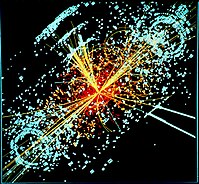
Photo from wikipedia
We analyze how to parametrize general modifications of the dark matter perturbations equations in a model-independent way. We prove that a general model with an imperfect and non-conserved dark matter… Click to show full abstract
We analyze how to parametrize general modifications of the dark matter perturbations equations in a model-independent way. We prove that a general model with an imperfect and non-conserved dark matter fluid with bulk and shear viscosities and heat flux in a modified gravity scenario can be described with five general functions of time and scale. We focus on the sub-Hubble regime within the quasi-static approximation and calculate the observable power spectra of the galaxy distribution, galaxy velocities and weak lensing and find that these observables are only sensitive to three combinations of the initial five functions. Deviations of these three observable functions with respect to ΛCDM give us different characteristic signals which allow us to determine in which cases it is possible to discriminate a modification of gravity from an imperfect or non-conserved dark matter. Finally, we perform a Fisher forecast analysis for these three parameters and show an example for a particular model with shear viscosity.
Journal Title: Journal of Cosmology and Astroparticle Physics
Year Published: 2020
Link to full text (if available)
Share on Social Media: Sign Up to like & get
recommendations!